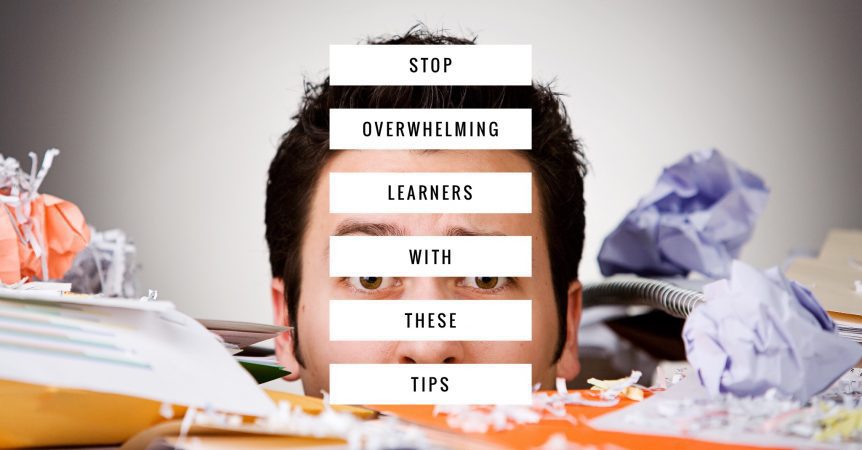Stop Overwhelming Learners with These Tips
Here’s a frustrating scenario you may have encountered: you create a visually stunning e-learning course packed full of on-topic content that you think explains exactly what the learner needs. They don’t get it though, so the results of the course are disappointing. One of the problems could be that you’re overwhelming learners.
There’s psychology behind this and it’s called cognitive load. It is a theory developed in the 1980s by John Sweller, an educational psychologist from Australia. In simple terms, cognitive load theory says learners can only process a certain amount of information. Once you go over that, you overload and overwhelm them.
Cognitive Load Theory Explained in Brief
According to the theory, the following three types of cognitive load exist:
- Intrinsic – where the content is too complex
- Extraneous – where the learning material makes it more difficult for the learner to learn
- Germane – when there is nothing in the course that helps the learner learn
How to Stop Overwhelming Learners When the Content is Complex
Intrinsic cognitive load is self-explanatory and there is not much you can do about it – if the topic is complex, it’s complex. One thing that can help in some situations is to do a pre-assessment of learners before they take the e-learning course. This will tell you whether they have the necessary knowledge foundation to complete the complex elements.
They will eventually, however, have to complete the complex material. As a result, you need to reduce the other two types of cognitive load as much as possible.
How to Stop Getting in the Way of Learners
While there may not be much you can do about intrinsic cognitive load, the other two types of cognitive load are within the control of the e-learning course designer.
An example of extraneous cognitive load is when you don’t use the appropriate media to explain a concept. For example, explaining what a hexagon looks like using words instead of showing an image of a hexagon.
So, to reduce overwhelming learners through extraneous cognitive load, remove or change anything that actively hinders their progress.
Here are some tips:
- Use microlearning principles – microlearning involves creating courses with modules that learners can complete in minutes. This forces you to remove superfluous content to focus only on the topic.
- Use the right media – vary the media types you use in the course, ensuring you use media that is appropriate to the content. Images and infographics are particularly helpful.
- Remove clutter from the design – dump anything that will distract the learner.
Include Things that Will Help the Learner
To deal with germane cognitive load, you should include strategies and elements that help the learner.
This includes:
- Use short course strategies – instead of a creating large, multi-faceted course, build a library of shorter courses. This makes it easier for the learner to progress in a way that suits them, plus it makes it easy to refer back to the material to refresh their memory.
- Make modules short – this is back to microlearning principles again. You will help the learner if you make modules short and focused on a single topic. Putting them all together will achieve your objective, but doing it on a modular basis where each module is bite-size is less likely to overwhelm the learner.
- Use the spaced repetition learning technique – spaced repetition is a learning technique that accepts people cannot retain information in one sitting. You, therefore, repeat the information in subsequent sittings, gradually increasing the interval between each repetition. This helps the learner embed the information in their long-term memory.
- Make it relevant – don’t present information to learners in a theoretical or abstract way. Instead, make it as relevant as possible. For example, use scenarios involving real-life situations the learner could encounter. This context will help the learner grasp the concept and it will help them retain the knowledge.
- Use personalised learning techniques – this involves giving the learner greater control over how they progress through the course. In other words, letting the learner take steps to stop themselves from becoming overwhelmed. This could be letting the learner decide the order to take modules, or letting them watch a video rather than reading text.
Finally, you should adopt an approach that involves constantly evaluating and optimising the e-learning courses you offer. This means analysing learner metrics and results to get an understanding of how learners deal with the course and the success they achieve. For example, did learners spend longer on a module than you anticipated, or was there a question in the post-course assessment that a lot of learners got wrong?
This information will indicate where learners became overwhelmed. You can ask them too, and then use the information to optimise your offering.
